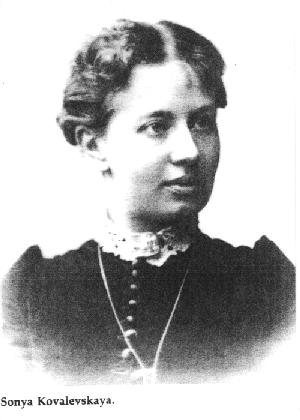Women in Mathematics
Sofia Kovalevskaya

For this weekly post I decided to research "Historical Women in Mathematics." I began reading tiny summaries of the work these women did and came across one, Sofia Kovalevskaya. The reason I gained interest in this woman was because like the gentleman in the first book I read, Love & Math, she was unable to pursue an education in mathematics because she lived in Russia. While his hardship was due to his nationality, Kovalevskaya's was because of her gender.
Sofia's exposure to mathematics began at a very young age. She credits her Uncle Peter for her interest in mathematics. Uncle Peter would discuss numerous abstractions and mathematical concepts with her. After teaching herself trigonometry at only fourteen years old, she went off to study in St. Petersburg. After finishing her secondary schooling, she was reading to study at a university level but such things were not permitted for women in Russia.
Kovalevskaya contracted a marriage to Vladimir Kovalevsky and moved to Germany. While she was still unable to attend university lectures, she was tutored privately and eventually received her doctorate after writing treatises on partial differential equations, Abelian integrals, and Saturn's rings. After her husband's death, she was appointed to a position as a lecturer in mathematics at the University of Stockholm. She became the first woman in that region of Europe to receive a full professorship.
Her written paper titled, "On the Theory of Partial Differential Equations," was published in 1875. In this paper, Kovalevskaya generalized a problem that was posed by Cauchy. Kovalevskaya had significantly simplified the proof of this problem and gave the theorem its definitive form. The theorem on the existence and uniqueness of solutions of partial differential equations can sometimes be referred to as the Cauchy-Kovalevskaya Theorem.
I researched what this theorem was and Wolfram-Alpha gave me this...
"This theorem states that, for a partial differential equation involving a time derivative of order
A visual representation of this can be seen on the following link:
http://www.encyclopediaofmath.org/index.php/Cauchy-Kovalevskaya_theorem
This theory is important because it shows that within a class of analytic solutions of analytic equations the number of arbitrary functions needed for a general solution is the same as the order of the equation and these arbitrary functions involve one less independent variable than the number occurring in the equation.
Later in 1880, a Russian mathematician, Chebyshev, invited Kovalevskaya to present a paper at his conference. She presented her dissertation paper on Abelian integrals. The paper was well received and a fellow mathematician offered to help find Kovalevskaya a job in his country. It was in 1884 that she was appointed her position as a professor at the University of Stockholm. A few years later, a competition was announced for the Prix Bordin. It was a prize competition for papers on the theory of the rotation of a solid body. Sofia was engaged in her research for this paper. Sofia submitted fifteen papers anonymously and one of her papers was considered so outstanding she received an even higher prize. Prior to the submission of this work, there were only two other solutions to the theory of the rotation of a solid body and both cases were when the body was symmetric. These cases were developed by Euler and Lagrange. Sofia described the first solvable case for an unsymmetrical top. Her work on Saturn Ring's is only briefly reviewed but she found the stability of motion of liquid ring-shaped bodies. Laplace found the form of the ring to be a skewed cross section of an ellipse. Kovalevskaya,using a series expansion, proved that the rings were egg-shaped ovals symmetric about a single axis. However, the subsequent proof that Saturn’s rings consist of discrete particles and not a continuous liquid made this work inapplicable.
In 1891, Sofia passed away. Her contributions to the mathematical field are remarkable. I was so interested to see yet again so many connections between different fields. She worked on a theorem with Cauchy which is a mathematician I learned about in 408, she also attended one of Chebyshev's lectures and we use one of his theorems in STA 412. Sofia Kovalevskaya was a great mathematician who opened the doors at universities to women. All of my findings talk about how passionate she was to her work and I can absolutely see that. Her story shows the struggles she was faced with being a female and how she overcame them. I think this is one of many female mathematician's whose work is inspiring and relate-able.
Sources:
http://www.smithsonianmag.com/science-nature/five-historic-female-mathematicians-you-should-know-100731927/?no-ist
http://www.maa.org/sites/default/files/pdf/pubs/Calc_Articles/ma072.pdf
http://www.agnesscott.edu/lriddle/women/kova.htm
http://www.encyclopediaofmath.org/index.php/Cauchy-Kovalevskaya_theorem
Good history, well sourced. Nice consolidation. 5Cs+
ReplyDeleteThis makes 6 weeklies by my count. FYI.
ReplyDelete